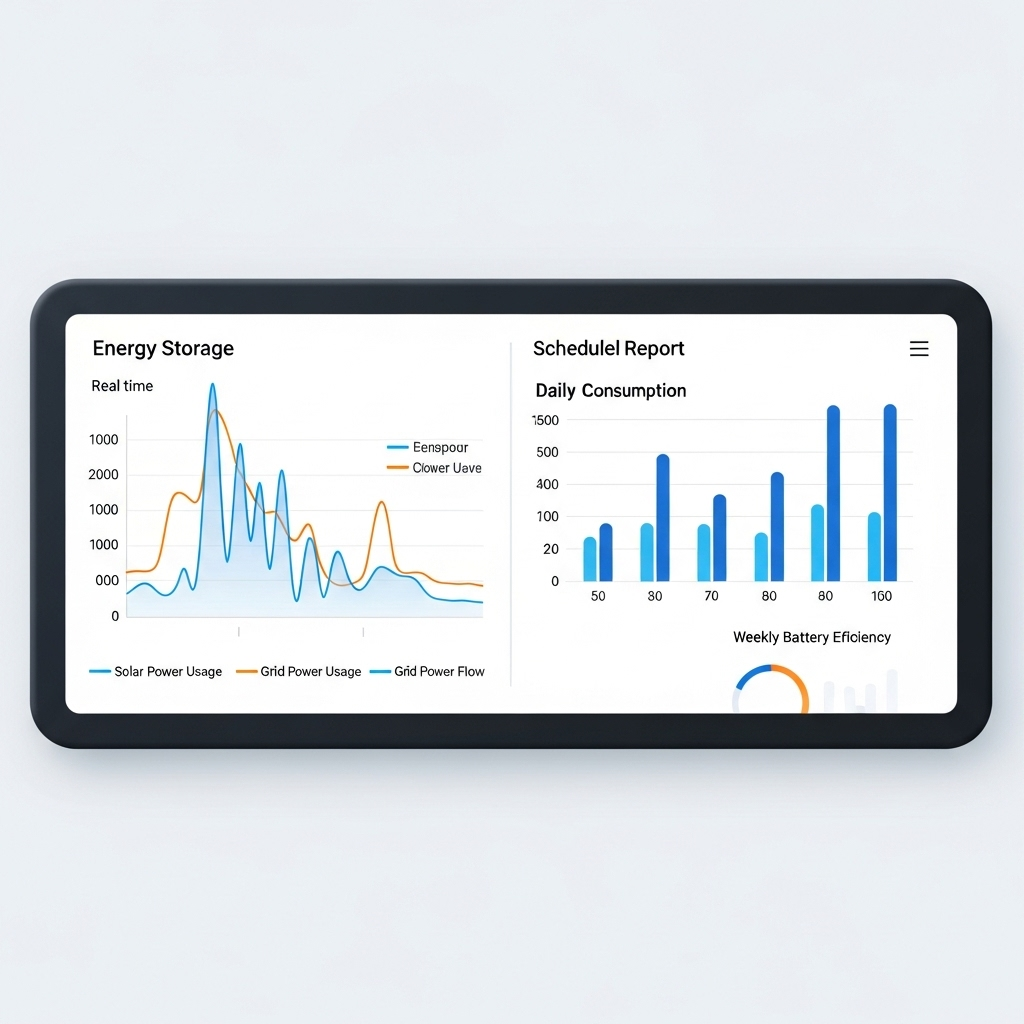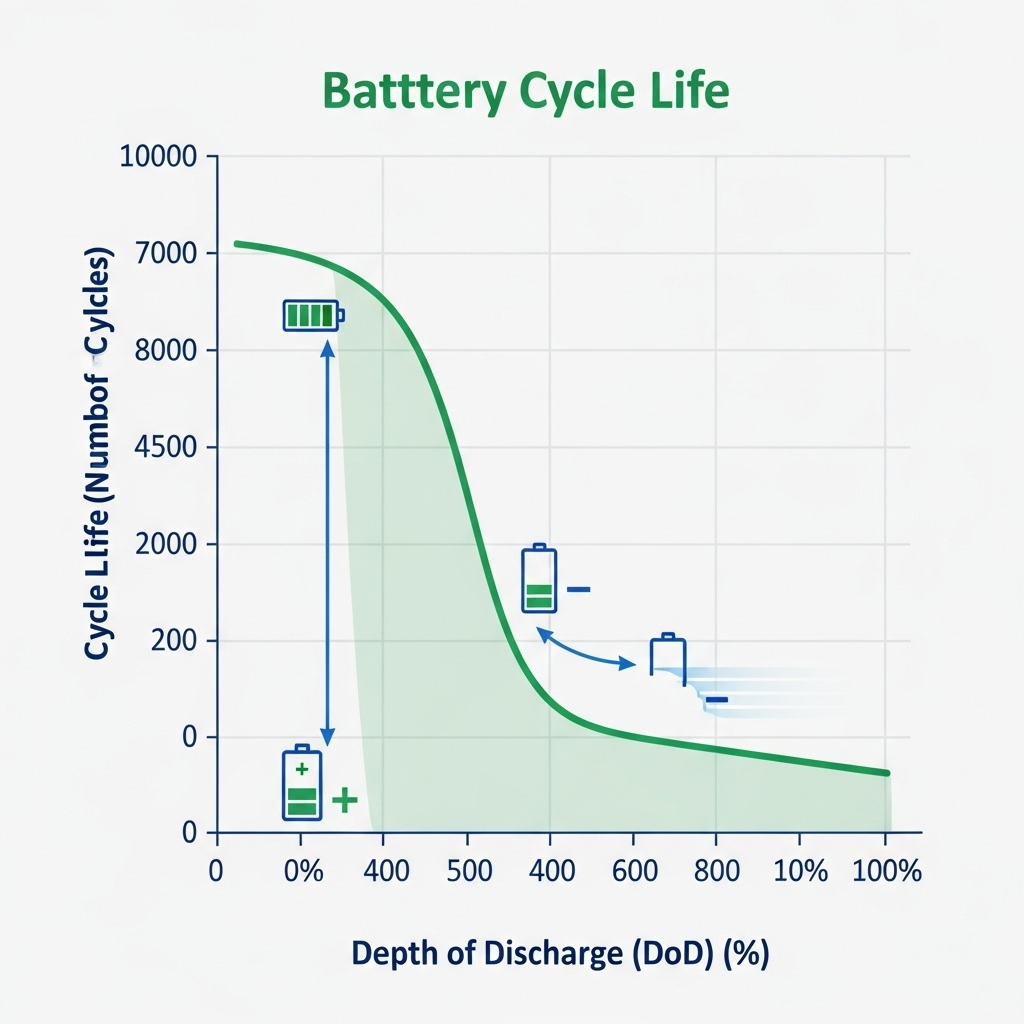Your home energy storage system (ESS) app is the command center for your energy independence. It provides a real-time view of your power generation and consumption. But to truly master your system, you need to understand the language it speaks. Three of the most critical metrics are State of Charge (SoC), State of Health (SoH), and Cycle Count. Understanding these figures allows you to optimize performance, extend your battery's lifespan, and protect your investment.
Decoding State of Charge (SoC): Your Battery's Fuel Gauge
Think of State of Charge as the fuel gauge for your battery. It provides an immediate snapshot of how much energy is currently stored, expressed as a percentage.
What SoC Represents
SoC is a straightforward metric: 100% means the battery is full, and 0% means it's empty. This percentage tells you the available energy at any given moment. Your home ESS uses this information to make smart decisions, such as when to store excess solar power or when to draw from the battery to power your home. Effective SoC monitoring ensures the battery operates within its ideal range, balancing your energy needs with the long-term health of the unit.
Practical Application in Your App
By checking your SoC, you can make informed decisions about your energy usage. For instance, if you see a high SoC in the afternoon, you know you have ample stored energy for the evening peak hours. If a storm is forecast, you can check that your SoC is near 100% to ensure maximum backup power. Maintaining an optimal SoC, typically between 20% and 80%, can help avoid stress on the battery and prolong its life.
SoC and Depth of Discharge (DoD)
SoC is directly related to another important concept: Depth of Discharge (DoD). DoD is the inverse of SoC; it measures how much energy has been used. If your battery's SoC is 70%, its DoD is 30%. Managing your system's typical DoD has a significant impact on its overall lifespan. Consistently deep discharges (a high DoD) put more strain on the battery than shallower discharges.
Understanding State of Health (SoH): The Long-Term Vitality Metric
While SoC is a real-time measurement, State of Health is a long-term indicator of your battery's condition. It reflects the battery's ability to hold a charge compared to when it was new.
Defining SoH
SoH is expressed as a percentage of the battery's original rated capacity. For example, if your 10 kWh battery has an SoH of 95%, its maximum storage capacity is now 9.5 kWh. All batteries experience some degradation over time due to chemical and physical changes; this is a normal process known as capacity fade. SoH is the metric that quantifies this process.
Why SoH Declines
A battery's SoH is affected by several factors, including its age, the number of charge-discharge cycles it has undergone, operating temperatures, and how deeply it is typically discharged. High temperatures and frequent deep discharges can accelerate the degradation process. A quality lithium iron phosphate (LiFePO4) battery is designed to minimize this decline, but it is an unavoidable aspect of battery chemistry.
Interpreting SoH in Your App
A slow, gradual decline in SoH is expected. For a well-maintained system, you might see a drop of a few percentage points over several years. A sudden, sharp drop in SoH could indicate an issue with a cell or the battery management system (BMS) and may warrant a professional inspection. Monitoring this metric helps you forecast the battery's future performance and understand when it might approach its end-of-life, which manufacturers often define as 70-80% SoH.
Tracking Cycle Metrics: Measuring Your Battery's Workload
The cycle count in your app tracks how many times your battery has been charged and discharged. This metric helps you understand the workload your battery has handled over its lifetime.
What is a Battery Cycle?
One cycle is equivalent to one full charge and one full discharge. However, this doesn't have to happen all at once. If you discharge your battery by 50% today, recharge it fully, and then discharge it by another 50% tomorrow, that counts as one complete cycle. Your ESS app tracks these partial cycles and aggregates them into an equivalent cycle count.
The Link Between Cycles, DoD, and Lifespan
The total number of cycles a battery can provide is not fixed; it is heavily influenced by the Depth of Discharge. Shallow discharges lead to a much longer cycle life. For LiFePO4 batteries, managing the DoD is key to maximizing longevity. Discharging to only 80% DoD can result in thousands more cycles compared to discharging to 100% DoD.
| Depth of Discharge (DoD) | Approximate Cycle Life (LiFePO4) |
|---|---|
| 100% | 3,000 - 4,000+ Cycles |
| 80% | 5,000 - 7,000 Cycles |
| 50% | 8,000 - 10,000 Cycles |
Note: These are estimates. Actual cycle life can vary based on battery quality, temperature, and other factors.
Using Cycle Data for Optimization
By observing your cycle count, you can gauge how hard your battery is working. A rapidly increasing cycle count might suggest your system is oversized for your needs or that your usage patterns are particularly demanding. This insight can help you adjust your energy habits or system settings to reduce unnecessary battery wear, ultimately extending its service life.
Putting It All Together for Optimal Performance
SoC, SoH, and Cycle Count are not isolated numbers; they are interconnected indicators of your system's performance and longevity. According to the International Energy Agency (IEA), battery storage is one of the fastest-growing energy technologies, making effective monitoring crucial for the clean energy transition.
A Practical Monitoring Routine
Develop a simple habit of checking these metrics:
- Daily (SoC): Glance at your SoC to manage daily energy flow and prepare for weather events or peak usage times.
- Weekly (Cycle Count): Review the cycle count to understand your recent usage patterns.
- Monthly (SoH): Check your SoH to track long-term degradation and ensure it is declining at a normal, gradual rate.
This proactive approach helps you stay ahead of potential issues. For a more detailed look at the factors that influence these numbers, you can consult this ultimate reference on solar storage performance. As research from the International Renewable Energy Agency (IRENA) points out, continuous improvements in battery technology and cost reductions are making home storage increasingly viable, and proper management ensures you reap the full benefits.
Your Path to Energy Mastery
Your home ESS app is more than a monitoring tool—it's a guide to achieving true energy independence. By learning to read and interpret SoC, SoH, and Cycle metrics, you transform from a passive energy consumer into an active manager of your own power. This knowledge empowers you to make smarter energy decisions, protect your hardware investment, and ensure your system delivers reliable, clean power for many years.
Frequently Asked Questions
What is a good SoH for a 5-year-old home battery?
For a quality LiFePO4 battery under normal use, an SoH of 85-95% after 5 years would be considered healthy. The exact value depends on the cycle count, operating temperature, and average depth of discharge during its life.
Can I improve my battery's SoH?
SoH degradation is an irreversible chemical process, so you cannot increase a battery's SoH. However, you can slow the rate of future decline by following best practices, such as avoiding extreme temperatures, maintaining the SoC between 20% and 80% when possible, and preventing frequent deep discharges.
Does my app's SoC reading affect my warranty?
While manufacturers primarily rely on internal data from the Battery Management System (BMS) for warranty claims, the usage patterns reflected in your app are related. Consistently operating the battery outside of the manufacturer's recommended parameters (e.g., temperature or DoD) could potentially impact a warranty claim. Always review your specific warranty documentation for details. This information is for educational purposes and does not constitute legal or investment advice.





Leave a comment
All comments are moderated before being published.
This site is protected by hCaptcha and the hCaptcha Privacy Policy and Terms of Service apply.